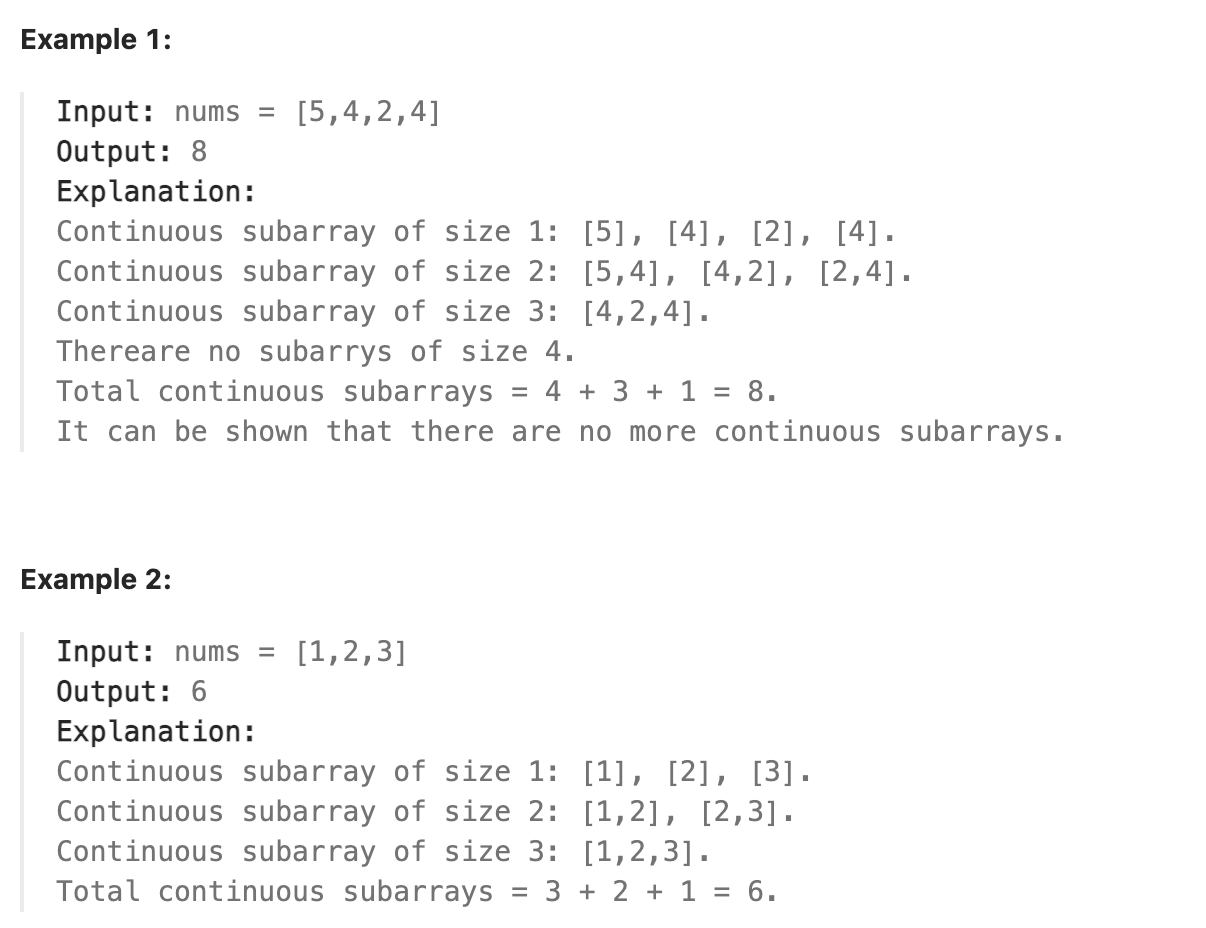[LeetCode] 2762.Continuous Subarrays
Continuous Subarrays
Let i, i + 1, …, j be the indices in the subarray
Then, for each pair of indices i <= i1, i2 <= j,
0 <= |nums[i1] - nums[i2]| <= 2
Step by Step Optimization (C++)
Brute Force
If
max - min > 2, break → otherwise, count subarrayOptimization
sliding window, monotonic deques
1. Brute Force
- simple and intuitive. but inefficient
Code (C++)
1
2
3
4
5
6
7
8
9
10
11
12
13
14
15
16
17
18
19
20
21
22
23
24
25
#include <iostream>
#include <vector>
#include <algorithm>
using namespace std;
int countSubarraysBruteForce(vector<int>& nums) {
int n = nums.size();
int total = 0;
for (int i = 0; i < n; i++) {
int mx = nums[i], mn = nums[i];
for (int j = i; j < n; j++) {
mx = max(mx, nums[j]);
mn = min(mn, nums[j]);
if (mx - mn > 2) break;
total++;
}
}
return total;
}
int main() {
vector<int> nums = {5, 4, 2, 4};
cout << countSubarraysBruteForce(nums) << endl;
}
Time Complexity : O(n^2)
Space Complexity : O(1)
- Only uses a few scalar variables (mx, mn, total, i, j). Therefore, no matter how large n is, the memory usage stays constant
2. Optimized
- maintain the max and min values efficicently with two deques (maxQ, minQ)
Pseudocode
1
2
3
4
5
6
7
8
9
10
11
12
13
14
15
16
17
18
19
20
int countSubarraysOptimized(vector<int>& nums)
1. for right from 0 to n-1
maxQ : not empty AND store "index of max"
→ nums[maxQ.front()] is always the maximum value
minQ : not empty AND store "index of min"
→ nums[minQ.front()] is always the minimum value
# deque is only store indices, not value
# nums[maxQ.back] → "maxQ.back == last index of maxQ"
2. while nums[maxQ.front] - nums[minQ.front] > 2
shrink window until valid: max - min <= 2
3. count all vaild subarrays
right = End index
left = vaild start index of the window
number of subarrays = right - left + 1
int main()
Code (C++)
1
2
3
4
5
6
7
8
9
10
11
12
13
14
15
16
17
18
19
20
21
22
23
24
25
26
27
28
29
30
31
32
33
34
35
36
37
38
39
#include <iostream>
#include <vector>
#include <deque>
using namespace std;
int countSubarraysOptimized(vector<int>& nums) {
int n = nums.size();
int total = 0;
int left = 0;
deque<int> maxQ, minQ;
for (int right = 0; right < n; right++) {
while (!maxQ.empty() && nums[maxQ.back()] <= nums[right]) {
maxQ.pop_back();
}
maxQ.push_back(right);
while (!minQ.empty() && nums[minQ.back()] >= nums[right]) {
minQ.pop_back();
}
minQ.push_back(right);
while (nums[maxQ.front()] - nums[minQ.front()] > 2) {
if (maxQ.front() == left) maxQ.pop_front();
if (minQ.front() == left) minQ.pop_front();
left++;
}
total += (right - left + 1);
}
return total;
}
int main() {
vector<int> nums1 = {5, 4, 2, 4};
vector<int> nums2 = {1, 2, 3};
cout << countSubarraysOptimized(nums1) << endl;
cout << countSubarraysOptimized(nums2) << endl;
}
deque
To get the max and min values in each step in
O(1)time, need to use dequemaxQ : indices of elements in decreasing order [
front = max, back = min]minQ : indices of elements in increasing order [
front = min, back = max]
Time Complexity : O(n)
- Each element is pushed and popped from each deque at most once
Space Complexity : O(n)
- In the worst case, deque can store up to
nindices
This post is licensed under CC BY 4.0 by the author.
